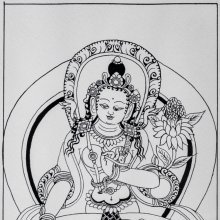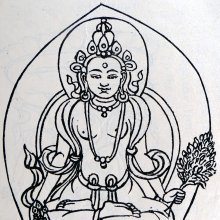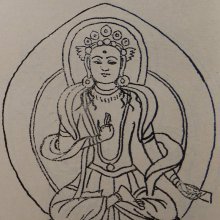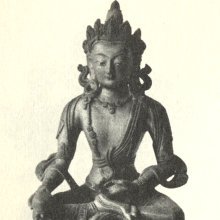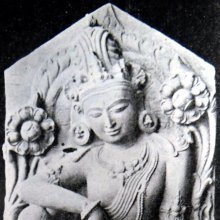Gaganaganja, Gaganagañja, Gagana-ganja: 11 definitions
Introduction:
Gaganaganja means something in Buddhism, Pali, Hinduism, Sanskrit. If you want to know the exact meaning, history, etymology or English translation of this term then check out the descriptions on this page. Add your comment or reference to a book if you want to contribute to this summary article.
Images (photo gallery)
(+4 more images available)
In Buddhism
Tibetan Buddhism (Vajrayana or tantric Buddhism)
Source: Wisdom Library: MañjuśrīnāmasaṃgītiGaganagañja (गगनगञ्ज) is one of the sixteen bodhisattvas appearing in the Vajradhātu-mahāmaṇḍala, according to the Nāmamantrārthāvalokinī v5.38-41. The Nāmamantrārthāvalokinī (literally, ‘an explanation of the nāma-mantras’) is a commentary (ṭīkā) on the 8th century Mañjuśrīnāmasaṃgīti.
Gaganagañja is a name of Mañjuśrī (the embodiement of non-dual knowledge) and, together with other names, forms the core essence of the Mañjuśrīnāmasaṃgīti. The Nāmamantrārthāvalokinī provides the practitioner a sādhana (‘meditative practice’) to turn these names into mantras. These mantras are chanted for the benefit of all beings, and then placed and contemplated in the Vajradhātu-mahāmaṇḍala, which is an extended version of the Vajradhātu-maṇḍala.
Source: Wisdom Library: Tibetan BuddhismGaganagañja (गगनगञ्ज) is the name of a Bodhisattva mentioned as attending the teachings in the 6th century Mañjuśrīmūlakalpa: one of the largest Kriyā Tantras devoted to Mañjuśrī (the Bodhisattva of wisdom) representing an encyclopedia of knowledge primarily concerned with ritualistic elements in Buddhism. The teachings in this text originate from Mañjuśrī and were taught to and by Buddha Śākyamuni in the presence of a large audience (including Gaganagañja).
Source: archive.org: The Indian Buddhist Iconography1) Gaganagañja (गगनगञ्ज) is the name of a Bodhisattva commonly depicted in Buddhist Iconography, and mentioned in the 11th-century Niṣpannayogāvalī of Mahāpaṇḍita Abhayākara.—his color is green; his symbol is the jewel.—Gaganagañja is also represented in the same form as his sire Ratnasambhava of yellow colour. In the Two Lamaistic Pantheons Gaganagañja occurs only once and he is of the same form as his sire Ratnasambhava. Fig. 53 is a Nepalese drawing of the Bodhisattva.
Gaganagañja is described in the Niṣpannayogāvalī as follows:
(1: Mañjuvajra-maṇḍala):—“Gaganagañja is of golden yellow colour. In the left he holds the Vajra with in clenched hand which is proudly placed on the hip, while the right is flourished upwards in the sky”. (2: Dharmadhātuvāgīśvara-maṇḍala):—“Gaganagañja is yellow and shows the Cintāmaṇi jewel in the right hand. In the left, he holds the auspicious bowl from which is suspended a Kalpa (wish-giving) tree”. (3: Durgatipariśodhana-maṇḍala):—“Gaganagañja is whitish yellow in complexion. He holds the Dharmagañja on lotus in the right hand, while his left hand rests on the hip”.
Gaganagañja is also described in the Sādhanamālā:—
“Gaganagañja of red colour, holds the blue lotus and exhibits the Varada-mudrā in his two hands”.
2) Gaganagañja (गगनगञ्ज) or Gaganagañjalokeśvara refers to number 48 of the 108 forms of Avalokiteśvara found in the Machhandar Vahal (Kathmanu, Nepal). [Machhandar or Machandar is another name for for Matsyendra.].
Accordingly,—
“Gaganagañja also is identical with [Avalokita Lokeśvara] in all respects except that he exhibits the Vitarka mudrā in his right hand and the book in his left.—Avalokita Lokeśvara also is one-faced and two-armed and sits in the same attitude on a lotus. He wields the sword in his right hand and holds the stem of a lotus against the chest with his left”.
The names of the 108 deities [viz., Gaganagañja] possbily originate from a Tantra included in the Kagyur which is named “the 108 names of Avalokiteshvara”, however it is not yet certain that this is the source for the Nepali descriptions.Source: Brill: Śaivism and the Tantric Traditions (tantric Buddhism)
Gaganagañja (गगनगञ्ज) refers to one of the sixteen Bhadrakalpa Bodhisattvas, according to the Niṣpannayogāvalī 44ff and Abhayākaragupta’s Durgatipariśodhana-maṇḍala (Cf. Niṣpannayogāvalī 66ff.).—A set of sixteen Bodhisattvas often supplements the deities of the Tattvasaṃgraha in later Vajradhātu-maṇḍala descriptions. These are generally the sixteen Bodhisattvas of the present aeon (bhadrakalpa) [e.g., Gaganagañja], as described for example in Abhayākaragupta’s Niṣpannayogāvalī Vajradhātu-maṇḍala.—Cf. also Nāmamantrārthāvalokinī and Abhayākaragupta’s forty-three deity Mañjuvajra-maṇḍala (Tricatvāriṃśadātmakamañjuvajra-maṇḍala: see Niṣpannayogāvalī 50)
Source: OSU Press: Cakrasamvara SamadhiGaganagañja (गगनगञ्ज) is the name of a deity [i.e., oṃ gaganagañjāya svāhā], according to the Guru Mandala Worship (maṇḍalārcana) ritual often performed in combination with the Cakrasaṃvara Samādhi, which refers to the primary pūjā and sādhanā practice of Newah Mahāyāna-Vajrayāna Buddhists in Nepal.—

Tibetan Buddhism includes schools such as Nyingma, Kadampa, Kagyu and Gelug. Their primary canon of literature is divided in two broad categories: The Kangyur, which consists of Buddha’s words, and the Tengyur, which includes commentaries from various sources. Esotericism and tantra techniques (vajrayāna) are collected indepently.
Mahayana (major branch of Buddhism)
Source: academia.edu: A Study and Translation of the GaganagañjaparipṛcchāGaganagañja (गगनगञ्ज) is the name of a Bodhisattva, according to the Gaganagañjaparipṛcchā: the eighth chapter of the Mahāsaṃnipāta (a collection of Mahāyāna Buddhist Sūtras).—Accordingly as The Lord said: “O Śāriputra, in the buddha-field of the Tathāgata Ekaratnavyūha, there is a Bodhisattva, the great being Gaganagañja who is resplendent by the splendor of merit (puṇyatejas), is without hindered knowledge, whose body was adorned with [the thirty-two] characteristics (lakṣaṇa), whose friendliness was adorned with [the eighty] minor marks (anuvyañjana), whose voice was adorned with eloquence (pratibhāna), whose thought was adorned with memory (dhāraṇī), [...]”.

Mahayana (महायान, mahāyāna) is a major branch of Buddhism focusing on the path of a Bodhisattva (spiritual aspirants/ enlightened beings). Extant literature is vast and primarely composed in the Sanskrit language. There are many sūtras of which some of the earliest are the various Prajñāpāramitā sūtras.
General definition (in Buddhism)
Source: Wisdom Library: Dharma-samgrahaGaganagañja (गगनगञ्ज) refers to the second of the “eight Bodhisattvas” (aṣṭabodhisattva) as defined in the Dharma-saṃgraha (section 12). The Dharma-samgraha (Dharmasangraha) is an extensive glossary of Buddhist technical terms in Sanskrit (e.g., aṣṭa-bodhisattva and Gaganagañja). The work is attributed to Nagarguna who lived around the 2nd century A.D.
Gaganagañja (“sky-jewel”) also refers to one of the “four concentrations” (samādhi) as defined in the Dharma-saṃgraha (section 136).
Languages of India and abroad
Sanskrit dictionary
Source: Cologne Digital Sanskrit Dictionaries: Edgerton Buddhist Hybrid Sanskrit DictionaryGaganagañja (गगनगञ्ज).—(or Gagaṇa°, so in Lalitavistara 295.10; Mahāvyutpatti 1336, but °na 700; °ṇa Kāraṇḍavvūha 38.13 ff., 49.17 ff., but °na 39.8), (1) name of a Bodhisattva: one of eight B's, Dharmasaṃgraha 12; (Ārya-)Mañjuśrīmūlakalpa 62.13; one of sixteen, (Ārya-)Mañjuśrīmūlakalpa 40.13; otherwise named Mahāvyutpatti 700; Lalitavistara 295.10; Śikṣāsamuccaya 127.1 (from Dharma- saṃgītisūtra); (Ārya-)Mañjuśrīmūlakalpa 68.21; 406.3; Sādhanamālā 49.16; Kāraṇḍavvūha, see above; (2) m., name of a work: Mahāvyutpatti 1336 Gagaṇagañjaḥ, probably = °ja-paripṛcchā, see note ad loc. and note on Śikṣāsamuccaya 33.11, or °ja-sūtra, q.v.; (3) name of a samādhi (one of four listed): Dharmasaṃgraha 136 (°ṇa° or °na°).
Source: Cologne Digital Sanskrit Dictionaries: Monier-Williams Sanskrit-English Dictionary1) Gaganagañja (गगनगञ्ज):—[=gagana-gañja] [from gagana] m. a kind of Samādhi, [Kāraṇḍa-vyūha xxiii, 162]
2) [v.s. ...] Name of a Bodhisattva, [xii, xvi; Lalita-vistara xx, 83.]
[Sanskrit to German]
Sanskrit, also spelled संस्कृतम् (saṃskṛtam), is an ancient language of India commonly seen as the grandmother of the Indo-European language family (even English!). Closely allied with Prakrit and Pali, Sanskrit is more exhaustive in both grammar and terms and has the most extensive collection of literature in the world, greatly surpassing its sister-languages Greek and Latin.
See also (Relevant definitions)
Partial matches: Gagana, Ganja.
Starts with: Gaganaganjalokeshvara, Gaganaganjasutra.
Full-text (+954): Four Concentrations, Pariccheda, Anutpannaniruddha, Ganja, Ashupratibhana, Samsthana, Mahasatva, Sthapaniya, Avatirya, Bodhisattva, Pratibhatu, Ratnavarsha, Prakashana, Dharmasamgraha, Maragocara, Ratnashri, Avaropita, Dharmaraja, Shastri, Dharmashravana.
Relevant text
Search found 4 books and stories containing Gaganaganja, Gaganagañja, Gagana-ganja, Gagaṇa-gañja, Gagana-gañja, Gagaṇagañja; (plurals include: Gaganaganjas, Gaganagañjas, ganjas, gañjas, Gagaṇagañjas). You can also click to the full overview containing English textual excerpts. Below are direct links for the most relevant articles:
The Indian Buddhist Iconography (by Benoytosh Bhattachacharyya)
108 forms of Avalokiteśvara (48): Gaganagañja Lokeśvara
Figure 53 - Bodhisattva Gaganagañja
Vimalakirti Nirdesa Sutra (by Robert A. F. Thurman)
Blue Annals (deb-ther sngon-po) (by George N. Roerich)
Chapter 4 - Lineage of Tropuwa < [Book 14 - Great Compassion Cycle]
Chapter 29 - Sonam Gyatso (vii): Labors for the doctrine < [Book 10 - The Kālacakra]
A History of Indian Philosophy Volume 1 (by Surendranath Dasgupta)
Part 11 - Mahāyānism < [Chapter V - Buddhist Philosophy]
